Prepare Financial Reports for Corporate Entities: FNSACC504 Report
VerifiedAdded on 2023/06/04
|6
|1595
|112
Report
AI Summary
This report analyzes the annual report of Brickworks Limited, addressing key aspects of financial reporting and accounting practices. The report examines the dissemination and target audience of the annual report, including shareholders, government, suppliers, employees, and investors. It details the information included in Brickworks Limited's 2015 annual report and how the company presents its financial data, including the use of digital formats and consolidated accounts. The analysis covers asset valuation methods, discrepancies in goodwill, financial position, tax rates, and the clarity of the report. It also addresses the use of accrual accounting, in-house coding and data classification, the chronological order of preparing consolidated accounts, the definition of fair value and deferred tax liability, and the financial statements and accounting records required by the company. The report concludes with an assessment of Brickworks Limited's overall financial performance and its compliance with reporting standards.
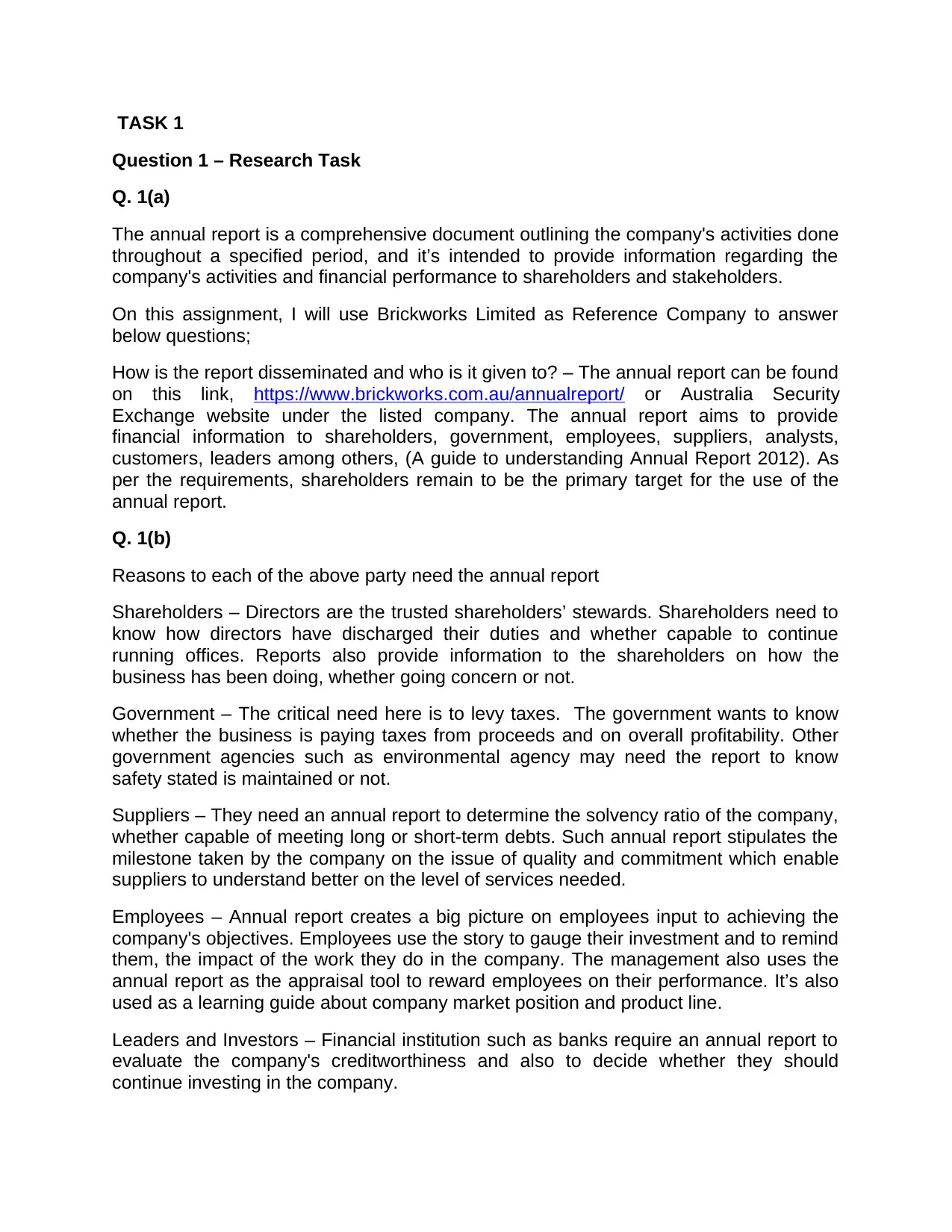
TASK 1
Question 1 – Research Task
Q. 1(a)
The annual report is a comprehensive document outlining the company's activities done
throughout a specified period, and it’s intended to provide information regarding the
company's activities and financial performance to shareholders and stakeholders.
On this assignment, I will use Brickworks Limited as Reference Company to answer
below questions;
How is the report disseminated and who is it given to? – The annual report can be found
on this link, https://www.brickworks.com.au/annualreport/ or Australia Security
Exchange website under the listed company. The annual report aims to provide
financial information to shareholders, government, employees, suppliers, analysts,
customers, leaders among others, (A guide to understanding Annual Report 2012). As
per the requirements, shareholders remain to be the primary target for the use of the
annual report.
Q. 1(b)
Reasons to each of the above party need the annual report
Shareholders – Directors are the trusted shareholders’ stewards. Shareholders need to
know how directors have discharged their duties and whether capable to continue
running offices. Reports also provide information to the shareholders on how the
business has been doing, whether going concern or not.
Government – The critical need here is to levy taxes. The government wants to know
whether the business is paying taxes from proceeds and on overall profitability. Other
government agencies such as environmental agency may need the report to know
safety stated is maintained or not.
Suppliers – They need an annual report to determine the solvency ratio of the company,
whether capable of meeting long or short-term debts. Such annual report stipulates the
milestone taken by the company on the issue of quality and commitment which enable
suppliers to understand better on the level of services needed.
Employees – Annual report creates a big picture on employees input to achieving the
company's objectives. Employees use the story to gauge their investment and to remind
them, the impact of the work they do in the company. The management also uses the
annual report as the appraisal tool to reward employees on their performance. It’s also
used as a learning guide about company market position and product line.
Leaders and Investors – Financial institution such as banks require an annual report to
evaluate the company's creditworthiness and also to decide whether they should
continue investing in the company.
Question 1 – Research Task
Q. 1(a)
The annual report is a comprehensive document outlining the company's activities done
throughout a specified period, and it’s intended to provide information regarding the
company's activities and financial performance to shareholders and stakeholders.
On this assignment, I will use Brickworks Limited as Reference Company to answer
below questions;
How is the report disseminated and who is it given to? – The annual report can be found
on this link, https://www.brickworks.com.au/annualreport/ or Australia Security
Exchange website under the listed company. The annual report aims to provide
financial information to shareholders, government, employees, suppliers, analysts,
customers, leaders among others, (A guide to understanding Annual Report 2012). As
per the requirements, shareholders remain to be the primary target for the use of the
annual report.
Q. 1(b)
Reasons to each of the above party need the annual report
Shareholders – Directors are the trusted shareholders’ stewards. Shareholders need to
know how directors have discharged their duties and whether capable to continue
running offices. Reports also provide information to the shareholders on how the
business has been doing, whether going concern or not.
Government – The critical need here is to levy taxes. The government wants to know
whether the business is paying taxes from proceeds and on overall profitability. Other
government agencies such as environmental agency may need the report to know
safety stated is maintained or not.
Suppliers – They need an annual report to determine the solvency ratio of the company,
whether capable of meeting long or short-term debts. Such annual report stipulates the
milestone taken by the company on the issue of quality and commitment which enable
suppliers to understand better on the level of services needed.
Employees – Annual report creates a big picture on employees input to achieving the
company's objectives. Employees use the story to gauge their investment and to remind
them, the impact of the work they do in the company. The management also uses the
annual report as the appraisal tool to reward employees on their performance. It’s also
used as a learning guide about company market position and product line.
Leaders and Investors – Financial institution such as banks require an annual report to
evaluate the company's creditworthiness and also to decide whether they should
continue investing in the company.
Paraphrase This Document
Need a fresh take? Get an instant paraphrase of this document with our AI Paraphraser
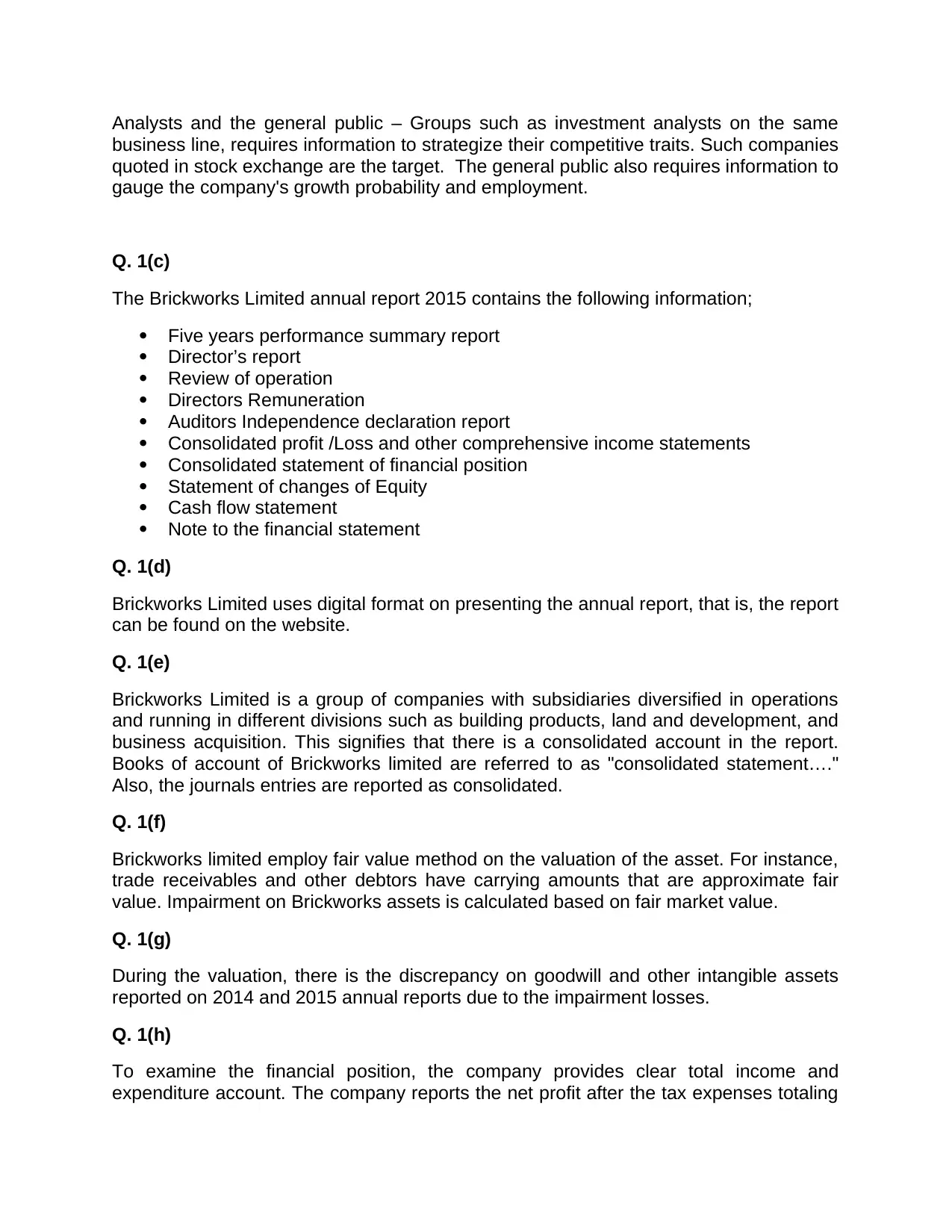
Analysts and the general public – Groups such as investment analysts on the same
business line, requires information to strategize their competitive traits. Such companies
quoted in stock exchange are the target. The general public also requires information to
gauge the company's growth probability and employment.
Q. 1(c)
The Brickworks Limited annual report 2015 contains the following information;
Five years performance summary report
Director’s report
Review of operation
Directors Remuneration
Auditors Independence declaration report
Consolidated profit /Loss and other comprehensive income statements
Consolidated statement of financial position
Statement of changes of Equity
Cash flow statement
Note to the financial statement
Q. 1(d)
Brickworks Limited uses digital format on presenting the annual report, that is, the report
can be found on the website.
Q. 1(e)
Brickworks Limited is a group of companies with subsidiaries diversified in operations
and running in different divisions such as building products, land and development, and
business acquisition. This signifies that there is a consolidated account in the report.
Books of account of Brickworks limited are referred to as "consolidated statement…."
Also, the journals entries are reported as consolidated.
Q. 1(f)
Brickworks limited employ fair value method on the valuation of the asset. For instance,
trade receivables and other debtors have carrying amounts that are approximate fair
value. Impairment on Brickworks assets is calculated based on fair market value.
Q. 1(g)
During the valuation, there is the discrepancy on goodwill and other intangible assets
reported on 2014 and 2015 annual reports due to the impairment losses.
Q. 1(h)
To examine the financial position, the company provides clear total income and
expenditure account. The company reports the net profit after the tax expenses totaling
business line, requires information to strategize their competitive traits. Such companies
quoted in stock exchange are the target. The general public also requires information to
gauge the company's growth probability and employment.
Q. 1(c)
The Brickworks Limited annual report 2015 contains the following information;
Five years performance summary report
Director’s report
Review of operation
Directors Remuneration
Auditors Independence declaration report
Consolidated profit /Loss and other comprehensive income statements
Consolidated statement of financial position
Statement of changes of Equity
Cash flow statement
Note to the financial statement
Q. 1(d)
Brickworks Limited uses digital format on presenting the annual report, that is, the report
can be found on the website.
Q. 1(e)
Brickworks Limited is a group of companies with subsidiaries diversified in operations
and running in different divisions such as building products, land and development, and
business acquisition. This signifies that there is a consolidated account in the report.
Books of account of Brickworks limited are referred to as "consolidated statement…."
Also, the journals entries are reported as consolidated.
Q. 1(f)
Brickworks limited employ fair value method on the valuation of the asset. For instance,
trade receivables and other debtors have carrying amounts that are approximate fair
value. Impairment on Brickworks assets is calculated based on fair market value.
Q. 1(g)
During the valuation, there is the discrepancy on goodwill and other intangible assets
reported on 2014 and 2015 annual reports due to the impairment losses.
Q. 1(h)
To examine the financial position, the company provides clear total income and
expenditure account. The company reports the net profit after the tax expenses totaling
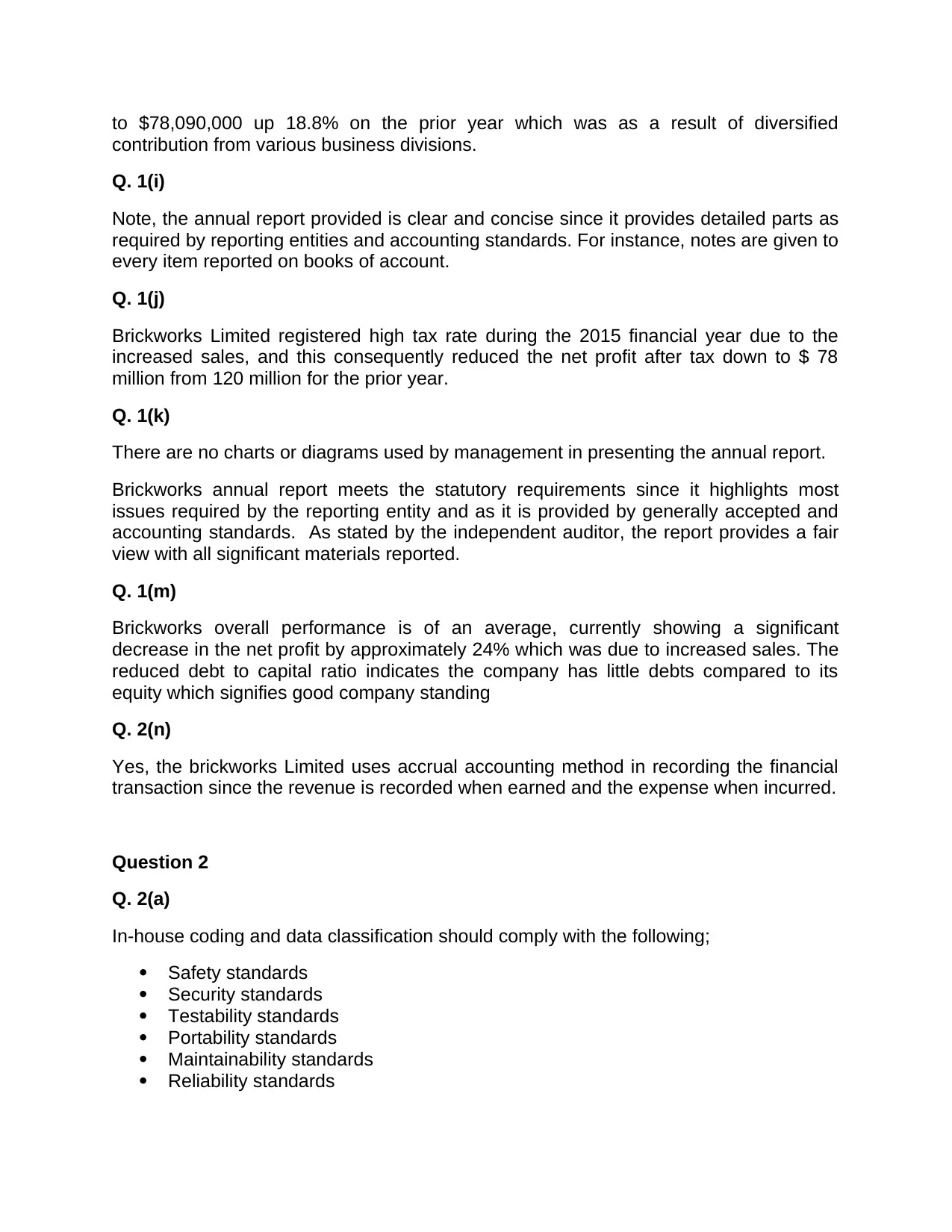
to $78,090,000 up 18.8% on the prior year which was as a result of diversified
contribution from various business divisions.
Q. 1(i)
Note, the annual report provided is clear and concise since it provides detailed parts as
required by reporting entities and accounting standards. For instance, notes are given to
every item reported on books of account.
Q. 1(j)
Brickworks Limited registered high tax rate during the 2015 financial year due to the
increased sales, and this consequently reduced the net profit after tax down to $ 78
million from 120 million for the prior year.
Q. 1(k)
There are no charts or diagrams used by management in presenting the annual report.
Brickworks annual report meets the statutory requirements since it highlights most
issues required by the reporting entity and as it is provided by generally accepted and
accounting standards. As stated by the independent auditor, the report provides a fair
view with all significant materials reported.
Q. 1(m)
Brickworks overall performance is of an average, currently showing a significant
decrease in the net profit by approximately 24% which was due to increased sales. The
reduced debt to capital ratio indicates the company has little debts compared to its
equity which signifies good company standing
Q. 2(n)
Yes, the brickworks Limited uses accrual accounting method in recording the financial
transaction since the revenue is recorded when earned and the expense when incurred.
Question 2
Q. 2(a)
In-house coding and data classification should comply with the following;
Safety standards
Security standards
Testability standards
Portability standards
Maintainability standards
Reliability standards
contribution from various business divisions.
Q. 1(i)
Note, the annual report provided is clear and concise since it provides detailed parts as
required by reporting entities and accounting standards. For instance, notes are given to
every item reported on books of account.
Q. 1(j)
Brickworks Limited registered high tax rate during the 2015 financial year due to the
increased sales, and this consequently reduced the net profit after tax down to $ 78
million from 120 million for the prior year.
Q. 1(k)
There are no charts or diagrams used by management in presenting the annual report.
Brickworks annual report meets the statutory requirements since it highlights most
issues required by the reporting entity and as it is provided by generally accepted and
accounting standards. As stated by the independent auditor, the report provides a fair
view with all significant materials reported.
Q. 1(m)
Brickworks overall performance is of an average, currently showing a significant
decrease in the net profit by approximately 24% which was due to increased sales. The
reduced debt to capital ratio indicates the company has little debts compared to its
equity which signifies good company standing
Q. 2(n)
Yes, the brickworks Limited uses accrual accounting method in recording the financial
transaction since the revenue is recorded when earned and the expense when incurred.
Question 2
Q. 2(a)
In-house coding and data classification should comply with the following;
Safety standards
Security standards
Testability standards
Portability standards
Maintainability standards
Reliability standards
⊘ This is a preview!⊘
Do you want full access?
Subscribe today to unlock all pages.

Trusted by 1+ million students worldwide
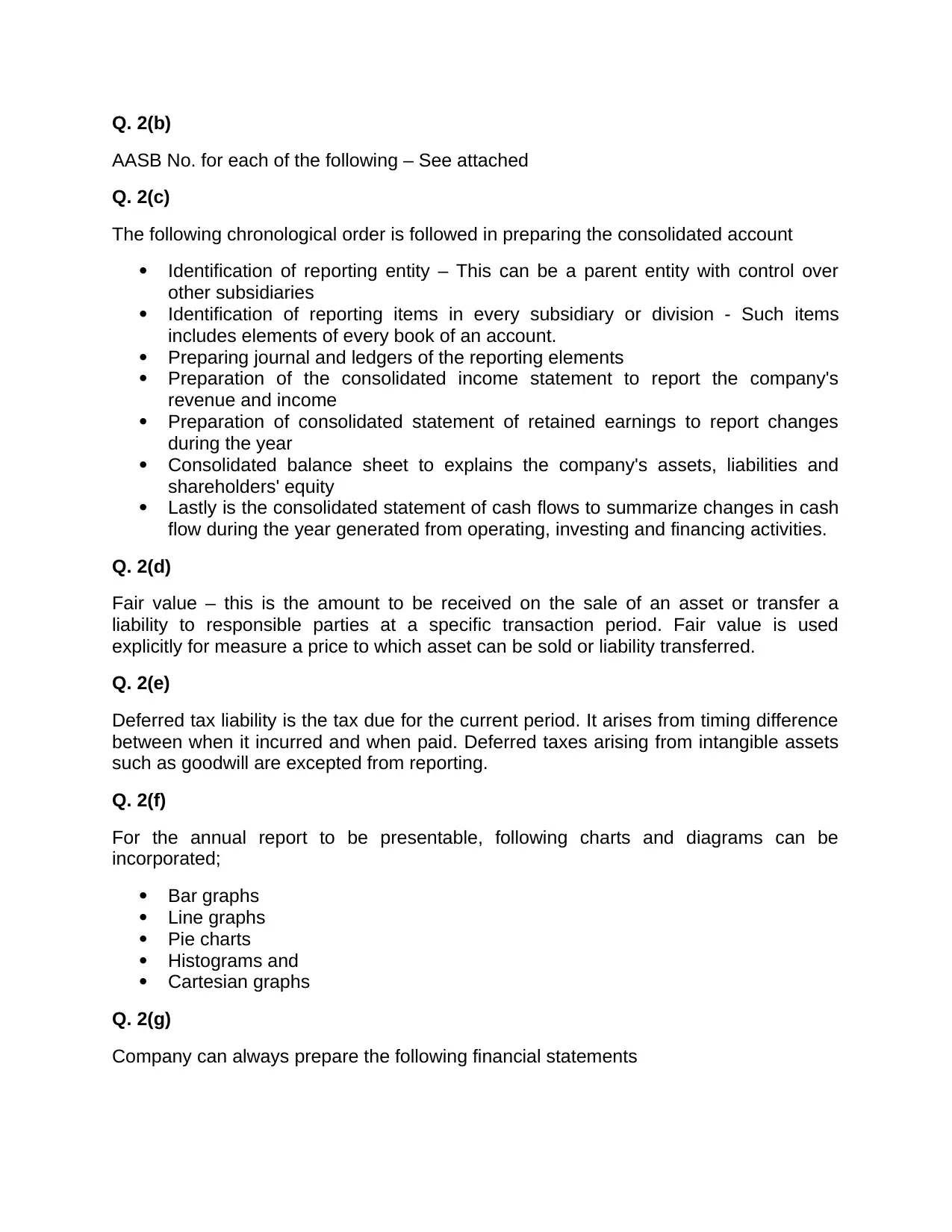
Q. 2(b)
AASB No. for each of the following – See attached
Q. 2(c)
The following chronological order is followed in preparing the consolidated account
Identification of reporting entity – This can be a parent entity with control over
other subsidiaries
Identification of reporting items in every subsidiary or division - Such items
includes elements of every book of an account.
Preparing journal and ledgers of the reporting elements
Preparation of the consolidated income statement to report the company's
revenue and income
Preparation of consolidated statement of retained earnings to report changes
during the year
Consolidated balance sheet to explains the company's assets, liabilities and
shareholders' equity
Lastly is the consolidated statement of cash flows to summarize changes in cash
flow during the year generated from operating, investing and financing activities.
Q. 2(d)
Fair value – this is the amount to be received on the sale of an asset or transfer a
liability to responsible parties at a specific transaction period. Fair value is used
explicitly for measure a price to which asset can be sold or liability transferred.
Q. 2(e)
Deferred tax liability is the tax due for the current period. It arises from timing difference
between when it incurred and when paid. Deferred taxes arising from intangible assets
such as goodwill are excepted from reporting.
Q. 2(f)
For the annual report to be presentable, following charts and diagrams can be
incorporated;
Bar graphs
Line graphs
Pie charts
Histograms and
Cartesian graphs
Q. 2(g)
Company can always prepare the following financial statements
AASB No. for each of the following – See attached
Q. 2(c)
The following chronological order is followed in preparing the consolidated account
Identification of reporting entity – This can be a parent entity with control over
other subsidiaries
Identification of reporting items in every subsidiary or division - Such items
includes elements of every book of an account.
Preparing journal and ledgers of the reporting elements
Preparation of the consolidated income statement to report the company's
revenue and income
Preparation of consolidated statement of retained earnings to report changes
during the year
Consolidated balance sheet to explains the company's assets, liabilities and
shareholders' equity
Lastly is the consolidated statement of cash flows to summarize changes in cash
flow during the year generated from operating, investing and financing activities.
Q. 2(d)
Fair value – this is the amount to be received on the sale of an asset or transfer a
liability to responsible parties at a specific transaction period. Fair value is used
explicitly for measure a price to which asset can be sold or liability transferred.
Q. 2(e)
Deferred tax liability is the tax due for the current period. It arises from timing difference
between when it incurred and when paid. Deferred taxes arising from intangible assets
such as goodwill are excepted from reporting.
Q. 2(f)
For the annual report to be presentable, following charts and diagrams can be
incorporated;
Bar graphs
Line graphs
Pie charts
Histograms and
Cartesian graphs
Q. 2(g)
Company can always prepare the following financial statements
Paraphrase This Document
Need a fresh take? Get an instant paraphrase of this document with our AI Paraphraser
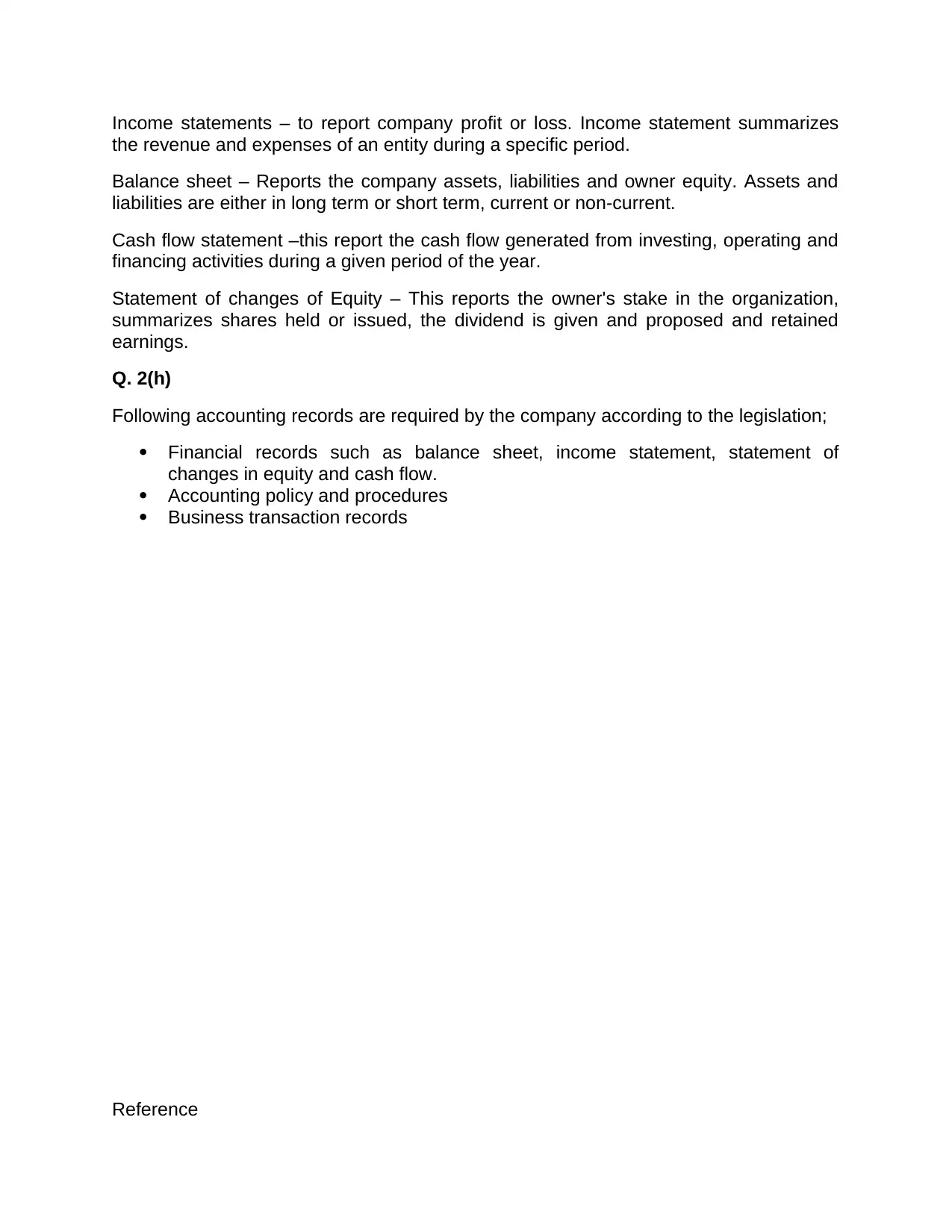
Income statements – to report company profit or loss. Income statement summarizes
the revenue and expenses of an entity during a specific period.
Balance sheet – Reports the company assets, liabilities and owner equity. Assets and
liabilities are either in long term or short term, current or non-current.
Cash flow statement –this report the cash flow generated from investing, operating and
financing activities during a given period of the year.
Statement of changes of Equity – This reports the owner's stake in the organization,
summarizes shares held or issued, the dividend is given and proposed and retained
earnings.
Q. 2(h)
Following accounting records are required by the company according to the legislation;
Financial records such as balance sheet, income statement, statement of
changes in equity and cash flow.
Accounting policy and procedures
Business transaction records
Reference
the revenue and expenses of an entity during a specific period.
Balance sheet – Reports the company assets, liabilities and owner equity. Assets and
liabilities are either in long term or short term, current or non-current.
Cash flow statement –this report the cash flow generated from investing, operating and
financing activities during a given period of the year.
Statement of changes of Equity – This reports the owner's stake in the organization,
summarizes shares held or issued, the dividend is given and proposed and retained
earnings.
Q. 2(h)
Following accounting records are required by the company according to the legislation;
Financial records such as balance sheet, income statement, statement of
changes in equity and cash flow.
Accounting policy and procedures
Business transaction records
Reference
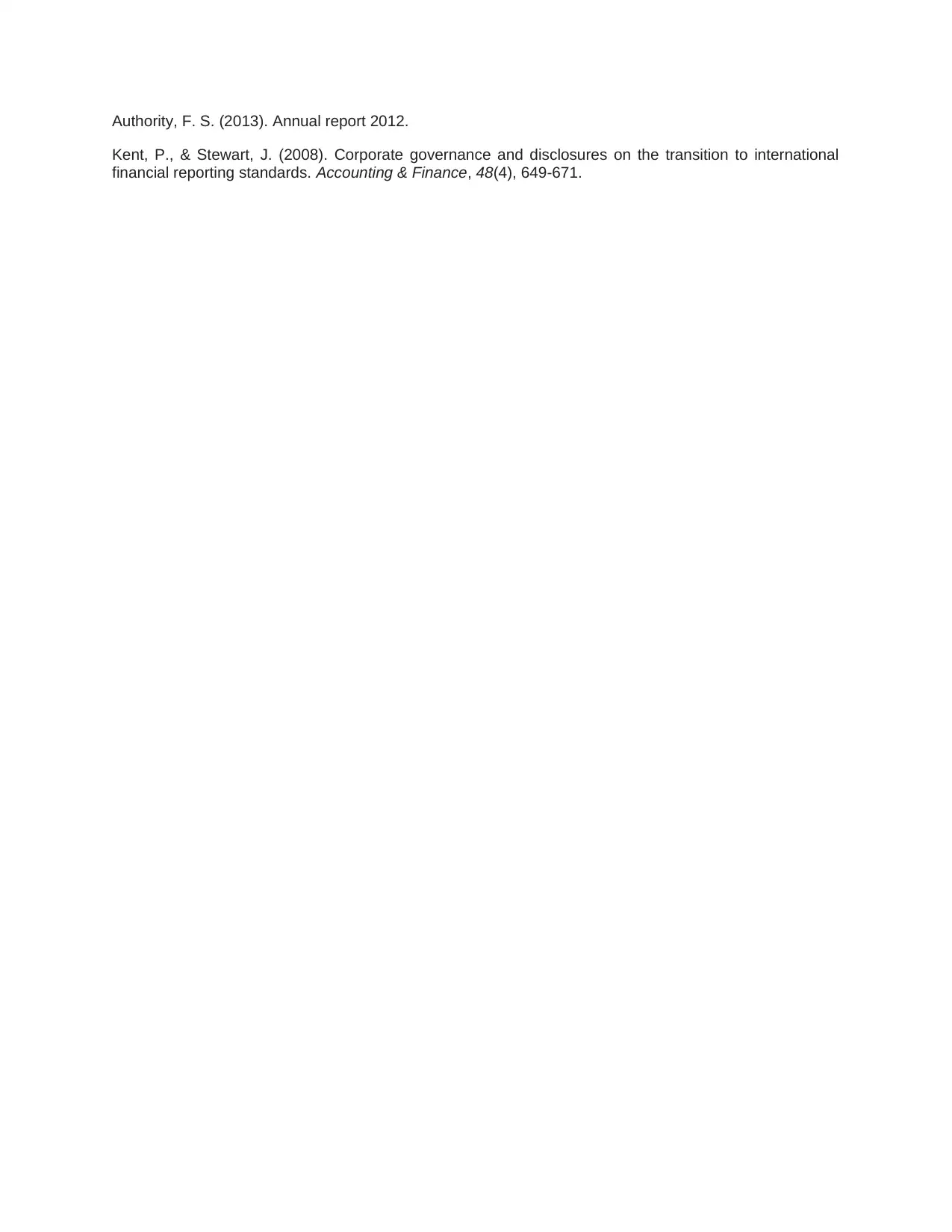
Authority, F. S. (2013). Annual report 2012.
Kent, P., & Stewart, J. (2008). Corporate governance and disclosures on the transition to international
financial reporting standards. Accounting & Finance, 48(4), 649-671.
Kent, P., & Stewart, J. (2008). Corporate governance and disclosures on the transition to international
financial reporting standards. Accounting & Finance, 48(4), 649-671.
⊘ This is a preview!⊘
Do you want full access?
Subscribe today to unlock all pages.

Trusted by 1+ million students worldwide
1 out of 6
Related Documents
Your All-in-One AI-Powered Toolkit for Academic Success.
+13062052269
info@desklib.com
Available 24*7 on WhatsApp / Email
![[object Object]](/_next/static/media/star-bottom.7253800d.svg)
Unlock your academic potential
Copyright © 2020–2025 A2Z Services. All Rights Reserved. Developed and managed by ZUCOL.



